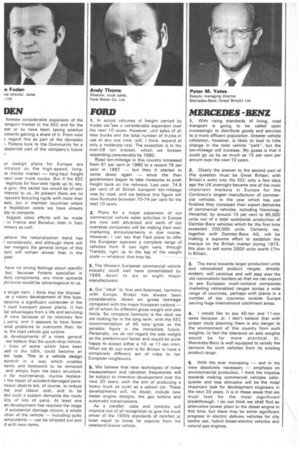DEN
Page 33

If you've noticed an error in this article please click here to report it so we can fix it.
foresee considerable expansion of the .ansport market in the EEC and for the 'ear or so have been taking positive owards gaining a share of it. From now a regard this as part of the domestic Fodens look to the Community for a ibstantial part of the company's future ur design plans for Europe are ntrated on the high-speed, longtractor market — long-haul -freight lent over trunk routes. But if the EEC legislate for four-axle rigids up to, say, Is gvw, this sector too would be of very nterest to us. At present there are no .oposals featuring rigids with more than axle, but • in member countries where
e legislation exists we have already ble to compete, biggest sales efforts will be made in France and Benelux; later in Italy rmany as well.
aelieve the rationalization trend has I considerably, and although there will her mergers the general tempo of this )ent will remain slower than in the past.
have no strong feelings about specific but, because Fodens specialize in duty components, any move upwards iht limits would be advantageous to us.
a single item, I think that the Wankel or a rotary development of this type, become a significant contender in the
f road transport power plants. It has lar advantages from a life and servicing 3.1 view because of its relatively few
parts, and it appears to have fewer onal problems to overcome than, for e, the road vehicle gas turbine.
to developments of a more general we believe that the quick-strip vehicle,
lines of some which have been aed in the USA, could become an 3nt type. This is a vehicle design scratch in a way which enables nents and bodywork to be removed and simply from the basic structure, it. for maintenance, routine replacer the repair of accident-damaged parts. ncipal objects are, of course, to reduce me and labour cost, and to be iful such a system demands the ready ility of kits of parts. At least one an development has reached the stage if substantial damage occurs, a whole ction of the vehicle — including quite ;omponents — can be stripped out and
d with new items.








































































































